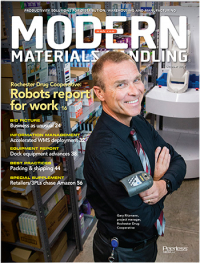Warehouse Basics: Sign, seal and deliver on customer promises
Packing and shipping—as the final step of fulfillment—are the last chance for an operation to ensure the job is well done.
Welcome to Warehouse Basics, a five-part series in which Modern will unpack the essential elements of functional areas in the warehouse. Informed by industry experts, these articles are intended to capture a snapshot of the current state of materials handling practices. We’ve moved from receiving through putaway, storage, replenishment and picking. Now, we turn to packing and shipping functions before orders leave the four walls.
In the previous installment of this series, we explored a range of solutions and processes to perform picking in your facility. The story was split into case picking and each picking, and we now follow the less-than-case stream into the pack and ship operations. After all, less-than-case are the orders that usually require packing.
Having picked the eaches for an e-commerce order, the container into which they were picked is now transported to a pack station. The container might be a tote or bin, or a corrugated box that will also serve as the shipping carton.
First, the pack station should be designed for optimum worker comfort. As recently as 10 years ago, the mere presence of an adjustable-height table was considered “best in class” from an ergonomic standpoint. Now, everything in the pack station is carefully arranged to limit reaching, stretching, repetitive motion and strain of any kind. Especially in seasonally sensitive e-commerce environments, it is common to install enough pack stations for peak seasons, even if that leaves several unoccupied for the remainder of the year.
If items arrive at the pack station in anything other than the shipping carton, there are several steps to prepare the order for shipment. At the most basic level, the item or items are placed into a poly bag or a corrugated box. “Autobaggers” are popular automated solutions that create bags, insert items, automatically seal the bags, and deposit them onto a sorter. In these setups, the last time a worker touches an item is when it is inducted to the autobagger.
Dunnage and void fill made of paper, plastic air bags, custom foam or other materials must be available to secure the product in the shipping carton. The role of such packing materials is to protect the product from damage or, as in the case of a garment that could be crumpled in transit, to ensure the product arrives at the consumer in a presentable manner.
Adding in automation
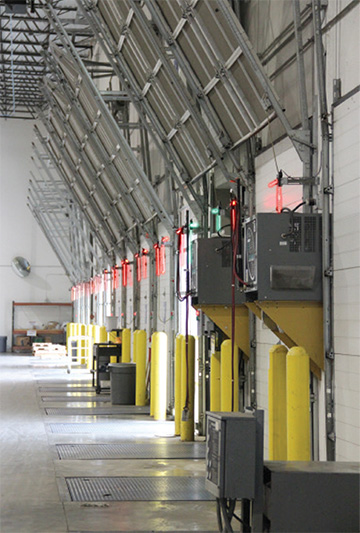 Automation can also create corrugated boxes on demand and reduce or eliminate the reliance on predetermined carton sizes for shipping, which can produce wasted space and increase shipping costs. Saving just a few pennies per box can quickly add up when multiplied by the millions of boxes shipped each year. On-demand auto-boxing solutions create a corrugated box customized to the dimensions of the order and then build the shipping carton around the items that comprise the order.
Automation can also create corrugated boxes on demand and reduce or eliminate the reliance on predetermined carton sizes for shipping, which can produce wasted space and increase shipping costs. Saving just a few pennies per box can quickly add up when multiplied by the millions of boxes shipped each year. On-demand auto-boxing solutions create a corrugated box customized to the dimensions of the order and then build the shipping carton around the items that comprise the order.
These types of solutions are becoming more commonplace as e-commerce volume grows. Dimensional weight rates such as those instituted by FedEx and UPS have created steep penalties for any company shipping cartons with unused space. The demand for efficient alternatives has driven investment and innovation in on-demand box creation or auto-boxing solutions that were previously not cost-effective.
Once the order is packed into a shippable container, the container must include a manifest, packing list or invoice of some sort, which might be manually or automatically inserted into the container at the pack station, or can be affixed to the outside of the container. At the pack station or shortly downstream, each container must also be marked with a shipping label. Some solutions create a packet with both the invoice and shipping label and automatically affix it to the container. In cases where orders are picked directly into the shipping container, the shipping label might be attached before the first item for the order is even picked.
The original business case for cubing and weighing systems was to optimize the use of storage space in the warehouse, but solutions have now evolved to provide additional value for distribution functions like cartonization and accurate manifesting.
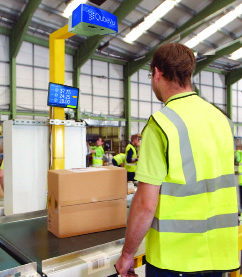 The warehouse or DC might round up dimensional information on receipt to coordinate putaway and optimize order fulfillment decisions, pre-pack and then shipment manifesting. A vendor might even supply some of the details in advance of receipt, and if the data is detailed enough it might be possible to pre-manifest a shipment—right down to void fill weight—and eliminate the labor to cube and weigh again downstream. Once collected, the dimensions of a new product can be put into the warehouse management system and supplied to any automated packing equipment.
The warehouse or DC might round up dimensional information on receipt to coordinate putaway and optimize order fulfillment decisions, pre-pack and then shipment manifesting. A vendor might even supply some of the details in advance of receipt, and if the data is detailed enough it might be possible to pre-manifest a shipment—right down to void fill weight—and eliminate the labor to cube and weigh again downstream. Once collected, the dimensions of a new product can be put into the warehouse management system and supplied to any automated packing equipment.
Insertion of value-added documents and materials like custom marketing for a familiar customer, for instance, has dwindled in recent years. Instead of manually or automatically inserting an assortment of additional coupons or catalogs, a significant portion of this function has been moved to the digital space, where such consumer-specific outreach is sent by e-mail or is presented directly to a customer on the retailer’s Website.
Sorting it out
Once packed and labeled, outbound parcels are sorted. The design of the sortation process is informed by the facility’s volume, location and position in the overall company network. For example, a single e-commerce facility servicing the entire United States may sort by zip code zone or parcel carrier zone to allow “zone skipping.” By contrast, if a facility is one of 10 in a network, you might configure sortation lanes by carrier instead of zip code. Sortation might also reflect varying service levels, with diverts and dock doors for next-day air, standard ground or somewhere in between.
The sortation will be more or less complex based on the options provided to the consumer; some retailers offer carrier options, some offer various delivery speeds, and others give no options at all. In any case, sortation for outbound parcels in an e-commerce facility is not nearly as complex as the shipping sortation required for a distribution center serving, say, 300 stores. A facility that is designed for store deliveries of hard goods, but also fulfills e-commerce orders, might leverage their existing shipping sorter. By adding outbound diverts to doors assigned to parcel carriers, the sorter can also effectively handle parcels. Poly bags, however, are not compatible with all carton sorters.
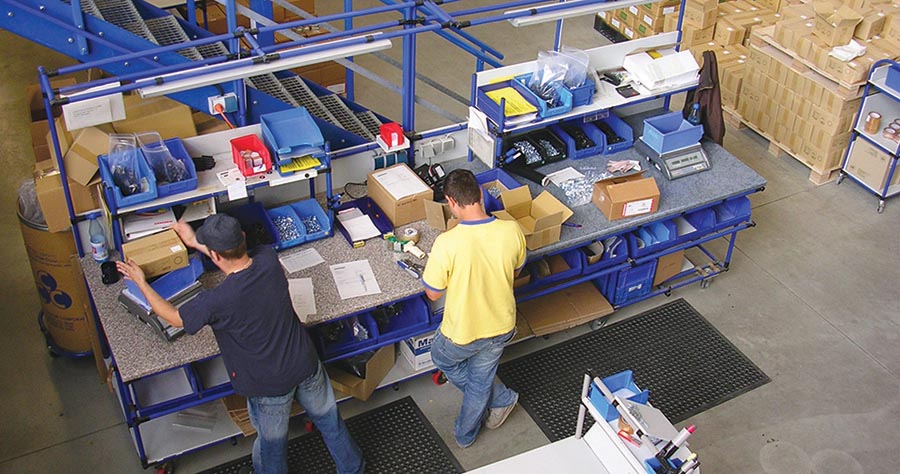
Parcels might be sorted into Gaylords, stacked on pallets, or floor-loaded into trucks. In cases where a facility does enough volume, the parcel carrier might staff the building with a driver who is responsible for loading the product, perhaps from an extendable conveyor in the trailer.
Setting the stage
As compared to parcel shipping, the staging and loading of case and pallet quantities requires more ample and disciplined dock space. Staging pallets before loading is especially important when route-stop sequencing is needed. To avoid confusion and ensure proper sequencing, it is best to dedicate a single forklift to the loading of each trailer, a practice called single-thread loading. A dock should offer about 60 feet of space to stage a trailer’s worth of pallets two abreast and verify orders before goods leave the facility.
The need for a clear and open staging bay has influenced the design of modern large-capacity buildings, nearly all of which will allow for 60 feet between the dock door and the first column line. In existing facilities where the first column line is, say, 40 feet from the dock doors, that does not mean the dock staging area should end at that point and racking begin.
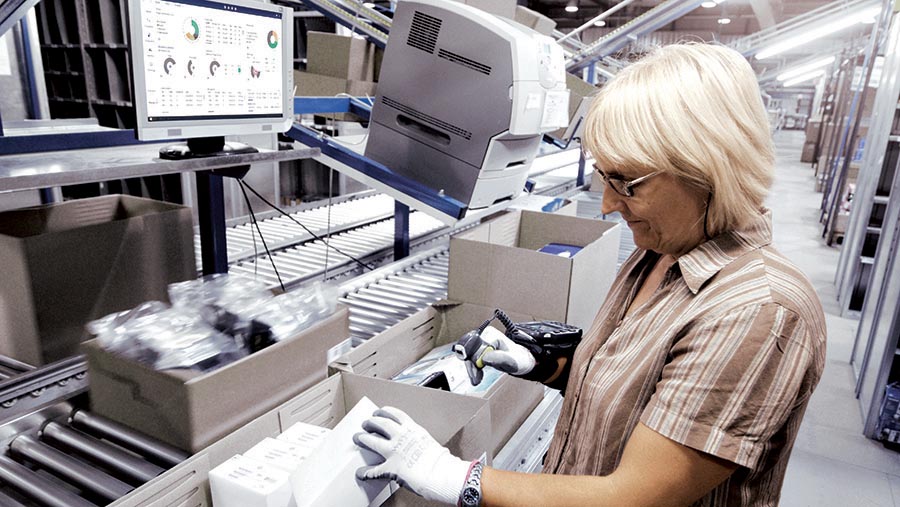
Packout is the last opportunity to confirm the accuracy of an order before it leaves the building.
The full 60 feet is still essential, even if the staging area now includes an obstacle in the form of a column. In fact, the placing of racks and aisles beyond the first row of columns is also an important consideration, since cramped pathways can be a recipe for congestion or collisions. In such cases it might be best to allow for 70 feet to ensure ample space.
Cube utilization software can help configure loads to optimize space utilization in each trailer. Such solutions also help ensure compliance with weight distribution and axle loading regulations.
If load sequencing is not an issue, multiple forklifts are free to load a truck, and less staging space is required. The warehouse management system (WMS) and load labeling will need to support a scan destination, in which the loads are scanned next to the door to ensure they are being loaded onto the correct truck. Some captive fleets have confirmation bar codes located inside the trailer.
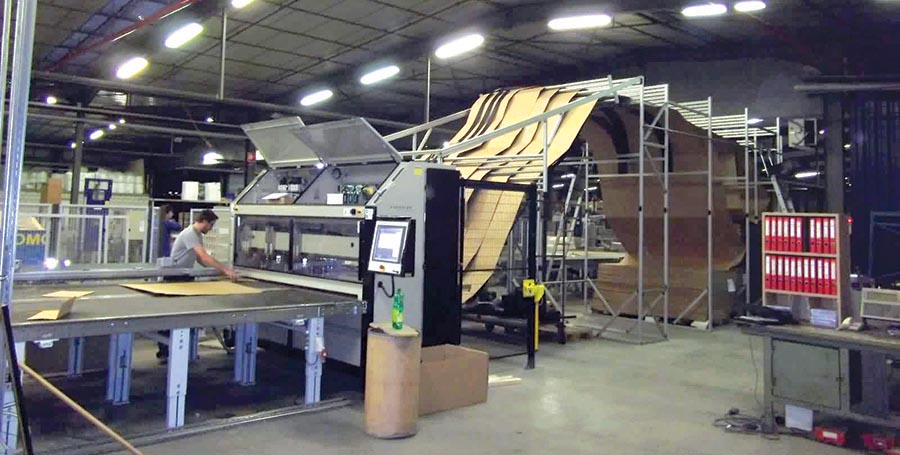
Automated carton-building solutions provide custom boxes on demand to optimize shipping costs.
Between the two extremes of full pallet loading and parcel shipping, there are operations including less-than-truckload (LTL) shipments and mixed-case pallets. Such pallets might be built during the picking process or after automatic sortation, but must be wrapped for stability in transit and affixed with a shipping label or bill of lading. They must also be labeled to ensure proper handling, such as warnings to avoid stacking pallets.
Because LTL trailers are sometimes used infrequently, the items to be loaded might be staged inside the dock before a trailer arrives. Or, if an operation has significant LTL volume with a single carrier, a dedicated trailer might occupy a dock until it is removed daily, or perhaps twice daily if volumes justify it. Again, organized staging areas are critical to keep loads accurate, segregated and properly sequenced.
This story was created with generous support from Bryan Jensen, who has 34 years of experience in retail and wholesale distribution, transportation and logistics and is a principal with St. Onge Co. in York, Pa. Contact Bryan at [email protected].

Article Topics
Packaging News & Resources
Registration open for Pack Expo International 2024 Pack Expo East has largest show to date Optimize Parcel Packing to Reduce Costs CMC Packaging Automation North America unveils Tech Center in Atlanta PACK EXPO East brings latest packaging technologies to Philadelphia Loftware’s cloud-based labeling solutions take center stage Flexcon unveils its innovative bin solutions More PackagingLatest in Materials Handling
Registration open for Pack Expo International 2024 Walmart chooses Swisslog AS/RS and software for third milk processing facility NetLogistik partners with Vuzix subsidiary Moviynt to offer mobility solutions for warehouses Materials Handling Robotics: The new world of heterogeneous robotic integration BSLBATT is looking for new distributors and resellers worldwide Lucas Watson appointed CSO for Körber’s Parcel Logistics business in North America Hyster recognizes Dealers of Distinction for 2023 More Materials HandlingAbout the Author
Subscribe to Materials Handling Magazine

Find out what the world's most innovative companies are doing to improve productivity in their plants and distribution centers.
Start your FREE subscription today.
April 2024 Modern Materials Handling

Latest Resources



